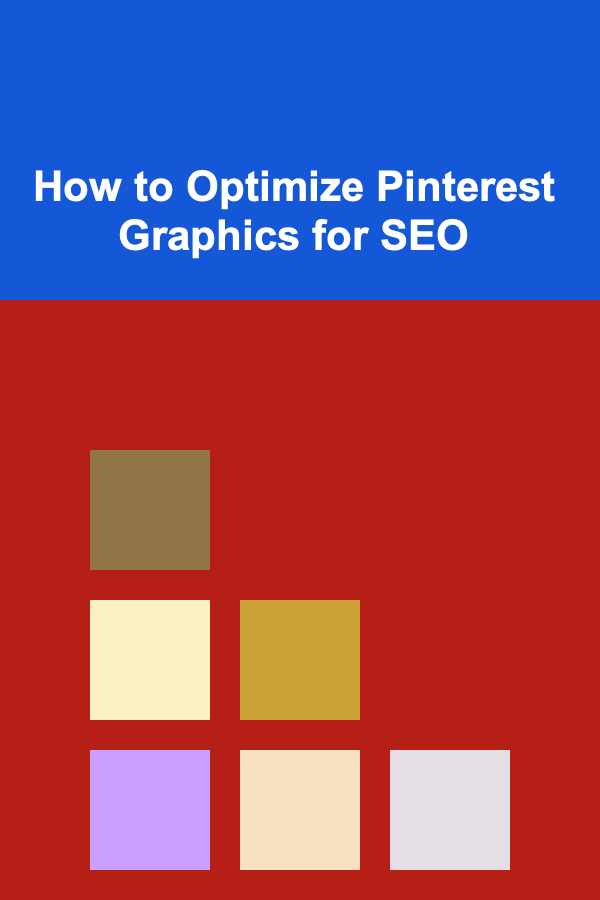
How to Optimize Pinterest Graphics for SEO
ebook include PDF & Audio bundle (Micro Guide)
$12.99$9.99
Limited Time Offer! Order within the next:

Pinterest is one of the most popular social media platforms for discovering new ideas, from recipes and home décor to fashion and DIY projects. As a visual search engine, Pinterest provides a unique opportunity for businesses, bloggers, and content creators to reach a vast audience. However, just posting high-quality images isn't enough to guarantee success. To fully leverage Pinterest's potential, you need to optimize your graphics for SEO to increase visibility and drive traffic to your website or business.
This guide will walk you through how to optimize Pinterest graphics for SEO, ensuring that your pins are not only aesthetically pleasing but also searchable and discoverable.
Understanding Pinterest's Search Algorithm
Before diving into specific strategies for optimizing Pinterest graphics, it's essential to understand how Pinterest's search algorithm works. Pinterest is not just a social media platform; it is a visual search engine. This means that people use Pinterest to find inspiration, discover new trends, and solve problems. Just like Google, Pinterest uses an algorithm to determine which pins appear in search results.
The algorithm prioritizes several factors:
- Relevance: Pins that match a user's search query are more likely to appear. Pinterest assesses the title, description, and image to determine relevance.
- Engagement: Pins that get more repins, clicks, and saves are seen as higher quality and are more likely to be shown in search results.
- Freshness: New content is favored, especially if it is gaining traction quickly. Regular posting helps keep your profile relevant in the algorithm.
- Rich Pins: Rich Pins include additional information such as prices, product descriptions, or ingredients and are considered more valuable by Pinterest's algorithm.
Now that we know how Pinterest evaluates content, let's explore how to optimize your graphics to maximize visibility and engagement.
Creating High-Quality Pinterest Graphics
The first step in optimizing your Pinterest graphics is ensuring that they are visually appealing. Pinterest is a highly visual platform, and users are drawn to striking, high-quality images. Here are some tips for creating eye-catching graphics:
Use Vertical Images
Pinterest is optimized for vertical images with a 2:3 aspect ratio. The ideal dimensions are 1000 x 1500 pixels. This format ensures that your pins stand out in users' feeds and are more likely to get noticed. Avoid horizontal images as they are harder to see and less likely to perform well on the platform.
Keep It Simple and Clean
Your graphics should convey the message at a glance. Avoid overcrowding the image with too much text or too many elements. A simple, clean design with a strong focal point is more likely to catch the eye of users.
Use Text Overlays
Adding text to your Pinterest graphics can help provide context and make your pin more discoverable. However, keep the text brief and legible. Use large fonts that are easy to read on both desktop and mobile devices. Choose a color that contrasts well with the background to ensure readability.
High-Quality Images
Use high-resolution, sharp images that reflect the quality of your content. Blurry or pixelated images can turn users away and decrease your credibility. If you're using stock photos, make sure they are high-quality and relevant to your content.
Crafting an SEO-Friendly Pin Title and Description
In addition to the visuals, the text in your pin also plays a crucial role in its discoverability. Optimizing the title and description for SEO is key to getting your pins noticed by Pinterest's search algorithm.
Pin Title Optimization
The title of your pin is one of the first things Pinterest's algorithm looks at when determining relevance. To optimize your title:
- Include Keywords: Use relevant keywords that your target audience is likely to search for. Think about what phrases people would type into Pinterest's search bar when looking for content like yours.
- Be Descriptive and Specific: A descriptive title helps users understand what they can expect when they click on your pin. Specific titles are more likely to match users' searches.
- Use Clear, Concise Language: Keep your title straightforward and easy to understand. Avoid keyword stuffing or using overly complicated language.
Example:
- Optimized Title: "Easy DIY Home Décor Ideas for Small Spaces"
- Non-Optimized Title: "DIY Home Décor"
Pin Description Optimization
The pin description is your opportunity to provide more context about your content. Pinterest allows up to 500 characters for descriptions, so make the most of this space by including relevant keywords, as well as an enticing call-to-action (CTA). Here are some tips for writing an SEO-friendly pin description:
- Use Relevant Keywords: Just like with the title, include keywords that align with what users are searching for. Keywords should appear naturally in the text; avoid keyword stuffing.
- Provide Context: Describe the content of the pin and what users can expect when they click on it. Use this space to highlight the value of the content.
- Include a Call to Action (CTA): Encourage users to click, save, or visit your website by including a CTA. For example: "Click to learn more," "Pin this for later," or "Visit our blog for more tips."
Example:
- Optimized Description: "Looking for simple ways to add style to small rooms? Check out these easy DIY home décor ideas for small spaces. Perfect for apartments or cozy homes! Pin this for later and start decorating your space today!"
- Non-Optimized Description: "DIY ideas for the home."
Use Hashtags in Your Description
Hashtags on Pinterest can help categorize your content and make it easier for users to find. Use relevant hashtags that relate to the content and keywords of your pin. You can add up to 20 hashtags, but don't go overboard; five to ten well-chosen hashtags are sufficient.
Utilizing Rich Pins for SEO
Rich Pins are an advanced type of Pinterest pin that automatically pull additional information from your website. These pins can include pricing, availability, product descriptions, and more. They make your pins more useful and engaging, which can boost your SEO on the platform.
There are several types of Rich Pins:
- Product Pins: Display the price, availability, and product details directly on the pin.
- Article Pins: Include the headline, author, and a brief description of the article.
- Recipe Pins: Show ingredients and cooking times, along with a photo of the finished dish.
By using Rich Pins, you provide more context and information, making your pins more useful to users and improving their chances of being clicked on and saved.
How to Enable Rich Pins
To enable Rich Pins, you must first verify your website with Pinterest. Then, you need to add meta tags to your site's code, which allows Pinterest to pull the necessary information into your pins automatically. Once enabled, your Rich Pins will display additional information like pricing, product details, and more.
Creating Pin-Ready Graphics with Canva
If you're not a graphic designer, you might find the idea of creating Pinterest graphics intimidating. However, tools like Canva make it easy to create beautiful, SEO-friendly graphics without any design experience.
Tips for Using Canva:
- Use Pinterest Templates: Canva offers pre-designed templates specifically for Pinterest. These templates are already optimized for the platform's preferred dimensions.
- Customize Templates: While templates provide a good starting point, customize them with your own colors, fonts, and images to match your branding.
- Add Text Overlays: Use the text tool in Canva to add catchy, concise text that describes your pin.
Leveraging Pinterest Analytics
Pinterest Analytics is an invaluable tool for tracking the performance of your pins. It provides insights into which pins are getting the most engagement, which keywords are driving traffic, and which demographics are interacting with your content. Use this data to adjust your strategy and refine your SEO approach.
Key Metrics to Monitor:
- Impressions: The number of times your pin has been seen.
- Engagements: The total number of interactions (clicks, saves, etc.) your pin has received.
- Click-Through Rate (CTR): The percentage of people who clicked on your pin compared to the number of impressions it received.
- Saves: The number of times your pin was saved to other boards, which increases its visibility.
By monitoring these metrics, you can identify what's working and what's not, allowing you to make data-driven decisions for future pin designs and SEO strategies.
Conclusion
Optimizing Pinterest graphics for SEO is essential for maximizing your visibility and driving traffic to your website. By creating high-quality, vertical images, crafting SEO-friendly titles and descriptions, and utilizing Rich Pins and hashtags, you can increase your chances of being discovered by Pinterest users. With the right strategy and tools, you can effectively use Pinterest as a powerful marketing platform to grow your brand and engage with a larger audience.
Reading More From Our Other Websites
- [Star Gazing Tip 101] Romantic Constellations: Crafting the Perfect Star-Gazing Date Night
- [Paragliding Tip 101] Soaring Together: Highlights from This Year's International Paragliding Meet-Ups
- [Small Business 101] How to Build a Brand Story That Resonates with Millennial Small‑Biz Customers
- [Weaving Tip 101] DIY Guide: Creating Modern Geometric Weave Designs with Simple Tools
- [Home Rental Property 101] How to Write a Lease Agreement That Protects Your Interests as a Landlord
- [Paragliding Tip 101] Best Low‑Noise Paragliding Wings for Silent Soaring Over Nature Reserves
- [Tie-Dyeing Tip 101] The Ultimate Guide to Tie‑Dyeing Apparel as Thoughtful Handmade Presents
- [Personal Finance Management 101] How to Manage Subscriptions and Recurring Expenses
- [Home Security 101] How to Choose the Best Home Security Camera for Your Needs
- [Beachcombing Tip 101] Discovering Nature's Gems: Educational Beachcombing Adventures for Children

How to Create a Boho Chic Home on a Budget
Read More
How to Organize Your Email Inbox for Less Stress
Read More
How to Save Money by Cutting Down on Credit Card Annual Fees
Read More
How to Set Up a Luxury Crafting Corner for DIY Projects
Read More
How to Incorporate Antioxidant Serums Daily
Read More
How to Craft Compelling Press Releases That Get Noticed
Read MoreOther Products

How to Create a Boho Chic Home on a Budget
Read More
How to Organize Your Email Inbox for Less Stress
Read More
How to Save Money by Cutting Down on Credit Card Annual Fees
Read More
How to Set Up a Luxury Crafting Corner for DIY Projects
Read More
How to Incorporate Antioxidant Serums Daily
Read More